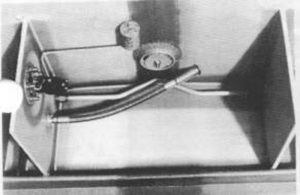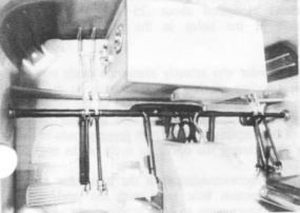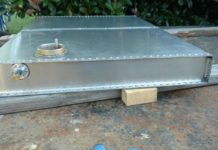Written by Mike Jones

The flexible flop tube is Aircraft Spruce part number 0520500 which lists for $26.85. I modified two of their AN867-2 welding flanges at $6.65 to accommodate the flop tube on the inside of the tank and an AN822-6D elbow on the outside. The modifications consisted of removing the raised portion at the back of each flange to permit bonding them together, milling flats on the protruding portions of a 3/4 end wrench, and drilling some depressions on the fares of the flanges for an improved mechanical bond with the cabosil mix. The side panel of the fuel tank was drilled to accept the protruding portion of the fitting and then relieved to accept the flanges which had been bonded back to back with Hot Stuff. After filling the remainder of the depression with a cabosil mix, a two layer laminate was applied to both inside and outside surfaces.

When located as shown, the tube does not interfere with either the vent line or the fuel sender float.
The vent bridge has three 7/32″ holes drilled at its peak which permits filling to the lower surface of the filler opening. Capacity is 6.5 gallons as shown with right side brakes.
Aircraft Spruce part numbers for the fuel measuring components are:
- Rochester sending unit 8341-3 @ $22.40
- Rochester fuel level gauge 3090-106 @ $82.35
- Lighting kit 10553 @ $7.00
As you thought, the fuel level gauge is identical to the one you are using for the main tank. Thank you for helping me sort this out.

Incidentally, the outside of the header tank panels must be spaced a minimum of two inches from the master cylinder bracket laminations if the vent fittings are to be inserted in the position specified by the manual.
Photographs 1 and 2 show the completed header tank with vent, flop tube, fuel sender and drain hardware in place. The close-up of the drain line illustrates the 90- and 45-degree fittings used to avoid interference with cowl vent and rudder cables. I chose braided line rather than rigid tubing to minimize the effects of any vibration or chafing.



